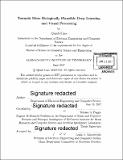| dc.contributor.advisor | Tomaso A. Poggio. | en_US |
| dc.contributor.author | Liao, Qianli | en_US |
| dc.contributor.other | Massachusetts Institute of Technology. Department of Electrical Engineering and Computer Science. | en_US |
| dc.date.accessioned | 2017-10-18T15:10:04Z | |
| dc.date.available | 2017-10-18T15:10:04Z | |
| dc.date.copyright | 2017 | en_US |
| dc.date.issued | 2017 | en_US |
| dc.identifier.uri | http://hdl.handle.net/1721.1/111920 | |
| dc.description | Thesis: S.M., Massachusetts Institute of Technology, Department of Electrical Engineering and Computer Science, 2017. | en_US |
| dc.description | Cataloged from PDF version of thesis. | en_US |
| dc.description | Includes bibliographical references (pages 85-91). | en_US |
| dc.description.abstract | Over the last decade, we have witnessed tremendous successes of Artificial Neural Networks (ANNs) on solving a wide range of Al tasks. However, there is considerably less development in understanding the biological neural networks in primate cortex. In this thesis, I try to bridge the gap between artificial and biological neural networks. I argue that it would be beneficial to build ANNs that are both biologically-plausible and well-performing, since they may serve as models for the brain and guide neuroscience research. On the other hand, developing a biology-compatible framework for ANNs makes it possible to borrow ideas from neuroscience to improve the performance of AI systems. I discuss several aspects of modern ANNs that can be made more consistent with biology: (1) the backpropagation learning algorithm (2) ultra-deep neural networks (e.g., ResNet, He et al., 2016) for visual processing (3) Batch Normalization (Ioffe and Szegedy, 2015). For each of the three aspects, I propose biologically-plausible modifications of the ANN models to make them more implementable by the brain while maintaining (or even improving) their performance. | en_US |
| dc.description.statementofresponsibility | by Qianli Liao. | en_US |
| dc.format.extent | 91 pages | en_US |
| dc.language.iso | eng | en_US |
| dc.publisher | Massachusetts Institute of Technology | en_US |
| dc.rights | MIT theses are protected by copyright. They may be viewed, downloaded, or printed from this source but further reproduction or distribution in any format is prohibited without written permission. | en_US |
| dc.rights.uri | http://dspace.mit.edu/handle/1721.1/7582 | en_US |
| dc.subject | Electrical Engineering and Computer Science. | en_US |
| dc.title | Towards more biologically plausible deep learning and visual processing | en_US |
| dc.type | Thesis | en_US |
| dc.description.degree | S.M. | en_US |
| dc.contributor.department | Massachusetts Institute of Technology. Department of Electrical Engineering and Computer Science | |
| dc.identifier.oclc | 1005706061 | en_US |
